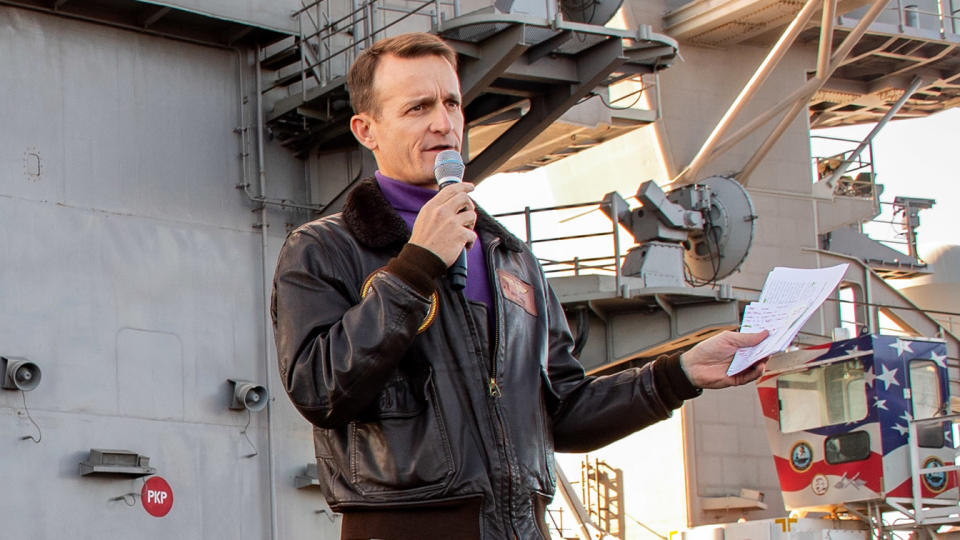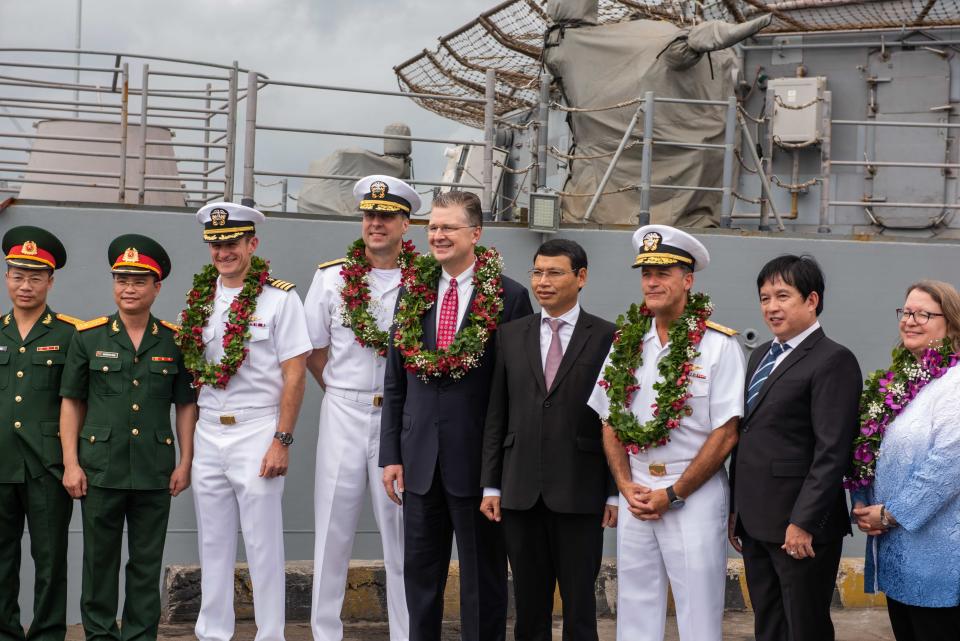'He must have felt like that was the only recourse': Captain of coronavirus-stricken carrier issues urgent plea to Pentagon for help
The captain of a coronavirus-stricken aircraft carrier would not have written a formal letter to his chain of command pleading for his sailors to be quarantined unless he felt he had exhausted all other options, according to a retired Navy officer who knows the captain well.
In an extraordinary letter that was first reported Tuesday by the San Francisco Chronicle, Capt. Brett Crozier said that while his ship, the Theodore Roosevelt, remains ready to “fight and beat any adversary that dares challenge the US or our allies,” doing so would involve taking “certain risks that are not acceptable in peacetime.” The letter amounts to a desperate appeal to his chain of command to get most of his sailors off the ship, where the virus is spreading out of control, and into individual quarantine lodgings that are based on federal guidelines.
But retired Cmdr. Guy “Bus” Snodgrass said the captain would not have written his letter unless he had first tried other avenues of less formal communication with his chain of command, such as email.
“You only write a formal four-page memorandum like he did, compelling action, if those informal processes have broken down,” said Snodgrass. “He must have felt like that was the only recourse left to him to get the desired response to take care of his crew.”
Snodgrass said he got to know Crozier when the latter was the executive officer of another carrier, the Ronald Reagan, and Snodgrass commanded an F/A-18 squadron in Japan that deployed to the carrier. “He is a leader of utmost character,” said Snodgrass. “He’s just a very calm, cool and collected kind of guy. He’s not prone to hyperbole, he’s not prone to getting overexcited over small things or big things.”
But Crozier’s bosses said they’re doing all they can to help the carrier, which is in port in Guam. Pacific Fleet commander Adm. John Aquilino told reporters Tuesday that while he was “on the same sheet of music” as Crozier, numerous “constraints” were preventing him from moving most of the carrier’s roughly 5,000 sailors off the ship as quickly as Crozier desired. Defense Secretary Mark Esper, meanwhile, told CBS Evening News that he had “not had a chance” to read Crozier’s letter “in detail,” but that “we’re not at that point” where the carrier needed to be evacuated.

“We’re moving a lot of supplies and medical assistance out to the carrier in Guam,” said Esper, adding that he was “going to rely on the Navy chain of command” to solve the problem. None of the crew was “seriously ill,” he said.
However, Esper said, he did agree with Crozier on one point. “Nobody of course needs to die at this point in time,” the defense secretary said. “We’re not at war. Priority No. 1 is taking care of our service members and their families.”
The Navy first announced three confirmed cases of COVID-19, the disease caused by the coronavirus, on the Theodore Roosevelt on March 24. In the week since, that number has risen to as many as 200, according to Navy Times, and the ship has been put into port at Guam, where it remains. The Theodore Roosevelt’s public affairs office did not respond to an emailed request for more information.
In his letter, Crozier said that as long as his crew members remain on the ship, the cramped conditions make it impossible to guarantee their safety by individually quarantining each sailor in his or her own room with a separate bathroom. He repeatedly noted that that sort of individual quarantine, which he said is “the only effective method to preserve an individual’s health,” is the type called for in guidelines issued by both the Navy and the Centers for Disease Control and Prevention.
In the absence of individual quarantine facilities, “the spread of the disease is ongoing and accelerating” aboard the carrier, Crozier wrote. “Decisive action is required now in order to … prevent tragic outcomes.”
The captain acknowledged that there are “challenges” in finding individual housing for his sailors. “This will require a political solution but it is the right thing to do,” he wrote. “We are not at war. Sailors do not need to die. If we do not act now, we are failing to properly take care of our most trusted asset — our Sailors.”
Aquilino said the Navy is trying to rotate the sailors off the ship in large groups, isolating and testing them for the coronavirus, before returning them when it’s confirmed that they are “full up COVID-free,” all while ensuring the vessel undergoes a thorough cleaning.
The Navy is working with Guam Gov. Lourdes Aflague Leon Guerrero to identify hotel rooms into which the sailors can move “as soon as possible,” Aquilino said. “The urgency has been highlighted.”

In a statement, the Navy made no firm promises that it would grant Crozier’s request. “The commanding officer of the Theodore Roosevelt alerted leadership in the Pacific Fleet on Sunday evening of continuing challenges in isolating the virus,” the statement said. “The ship’s commanding officer advocated for housing more members of the crew in facilities that allow for better isolation. Navy leadership is moving quickly to take all necessary measures to ensure the health and safety of the crew of USS Theodore Roosevelt, and is pursuing options to address the concerns raised by the commanding officer.”
The Navy has not confirmed how the virus got onboard the Theodore Roosevelt, but the decision to permit the carrier’s most recent port call before the first cases were confirmed is bound to be re-examined in light of the outbreak on the carrier. That port call was a five-day visit to Da Nang, Vietnam, which concluded on March 9. The Navy announced the first confirmed COVID-19 cases on the ship 15 days later.
Chief of Naval Operations Adm. Michael Gilday told reporters during a Pentagon press briefing on March 24 that in “late February, early March,” Adm. Philip Davidson, the head of U.S. Indo-Pacific Command, decided to allow the port visit because Vietnam had few confirmed cases. But a spokesperson for Indo-Pacific Command told Yahoo News that in giving the go-ahead for the port visit, Davidson was following Aquilino’s recommendation.
In a conference call with reporters on Tuesday, Aquilino said that at the time of the visit, World Health Organization (WHO) data showed only 16 confirmed cases of COVID-19 in Vietnam, all of which were in the capital, Hanoi, about 375 miles north of Da Nang. In addition, Vietnam had not had a new confirmed case in 20 days, he said. But Aquilino acknowledged that although every sailor was screened prior to reboarding the carrier in Da Nang, “the possibility still exists” that the virus came aboard at that time.
An Indo-Pacific Command March 12 press release about the port visit said that Aquilino himself visited Da Nang for a ceremony to mark the conclusion of the port visit. The release makes clear that the command and Pacific Fleet considered the port call an important diplomatic opportunity, a point that Aquilino also made in his conference call with reporters on Tuesday, saying that the visit was to recognize the 25th anniversary of the normalizing of diplomatic relations between the United States and Vietnam.

The U.S. ambassador to Vietnam, Daniel Kritenbrink, attended the ceremony, as did numerous Vietnamese officials, including representatives from the ministries of national defense and foreign affairs. The press release included a photograph of a group of Vietnamese and U.S. officials, including several Navy officers, standing close together and making no obvious attempt at social distancing.
World Health Organization daily COVID-19 updates confirm Gilday’s and Aquilino’s assertion that when the decision to green-light the port call was taken, Vietnam had only 16 confirmed cases of COVID-19. That number held steady from Feb. 13 through March 6.
But Vietnam is a developing country, so it’s not clear how much testing was actually occurring there nor whether the nation’s communist regime was being completely open about the number of cases. On Feb. 28, five days before the Theodore Roosevelt arrived in Danang, the WHO stated that at least some of Vietnam’s cases were the result of “local transmission.”
The number of confirmed cases in Vietnam began to rise again in the middle of the Theodore Roosevelt’s port call, with the 17th being registered on March 7. That figure had increased to 30 by the time the carrier left Da Nang, meaning Vietnam’s total number of confirmed cases had almost doubled in the space of the port visit. Because it typically takes someone with COVID-19 between two and 14 days to exhibit symptoms, the number of people with the disease in Vietnam at the time was likely much higher.
According to the World Health Organization, the number of confirmed cases in Vietnam as of March 30 stood at 188, which is less than the reported number aboard the Theodore Roosevelt.
_____
Click here for the latest coronavirus news and updates. According to experts, people over 60 and those who are immunocompromised continue to be the most at risk. If you have questions, please reference the CDC and WHO’s resource guides.
Read more:



